What Is an IDE?
An IDE, or Integrated Development Environment, enables programmers to consolidate the different aspects of writing a computer program.
An IDE typically contains a code editor, a compiler or interpreter, and a debugger, accessed through a single graphical user interface (GUI). The user writes and edits source code in the code editor. The compiler translates the source code into a readable language that is executable for a computer. The debugger tests the software to solve any issues or bugs.
Why are IDEs so important?
Even though developers know how to code, they will need a workplace with all the relevant tools. IDE will provide the developers with that work area all in one place. That’s why IDEs are very important.
Luckily, there are many options we have for programming or coding even some IDEs are specifically created for particular programming languages.
Here, we shortlisted top IDEs for general purposes.
1. Microsoft Visual Studio
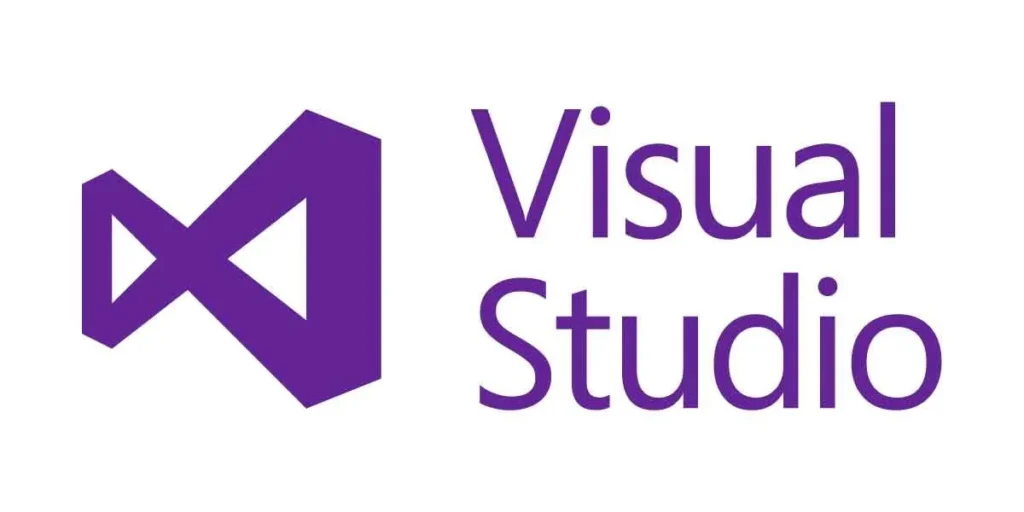
The Visual Studio IDE is a creative launching pad that you can use to edit, debug, and build code, and then publish an app. An integrated development environment (IDE) is a feature-rich program that is created and managed by Microsoft.
The main feature of Visual Studio is it has many in-built functions starting from syntax highlighting to high compatibility testing like you can test more than 300 devices and browsers. Thanks to its flexibility, Visual Studio is a great tool for both wings learners and professionals.
Languages Supported: It supports more than 100 languages some main of which are C++, C#, CSS, Dart, Dockerfile, Go, HTML, Java, JavaScript, JSON, PHP, PowerShell, Python, SCSS, SQL, and TypeScript.
Pros of Visual Studio:
- A massive library of extensions that is always growing
- Syntax highlighting and bracket matching
- Smart completions or IntelliSense
- Linting and corrections
- Code navigation (Go to Definition, Find All References)
- Debugging
- Refactoring
- Integrating with GitHub
- Customizable themes
- Imported modules
- Custom hotkeys
Cons of Visual Studio :
Visual Studio has many features which make it a heavyweight IDE, it takes considerable resources to open and run, so making simple edits may be time-consuming on some devices. For simpler tasks, it may not be a good choice.
2. Eclipse
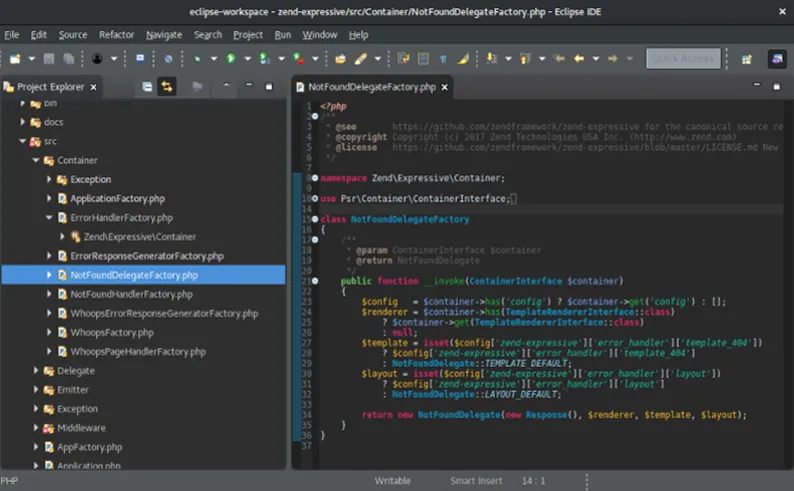
Eclipse is open source or free and one of the famous IDE for Java. It is a cross-platform desktop application.
It has a massive marketplace so you can easily combine multiple languages support and other features into any of our default packages, and the Eclipse Marketplace allows for virtually unlimited customization and extension.
The user interface provided by Eclipse is one of its most appealing elements. It allows a drop and drag functionality as well. You can also analyze your code using static analysis. It also supports elements such as debugging and profiling.
Languages supported: Java, C, C++, Perl, PHP, Python, Ruby, and more
Pros of Eclipse:
- Open Source
- Run and compile Java with ease.
- Task-focused interface including system-tray notifications
- Automated error reporting
- A plethora of package solutions allowing for multi-language support
- IntelliSense
- Support for different build systems like CMAKE
Cons of Eclipse
- No customization is allowed in the theme of the IDE
- Switching perspectives takes a bit much time
- Less Language Support
- Uses a lot of system resources / CPU
For a quick setup guide, read our blog How to Install Visual Studio Code in Ubuntu to learn step-by-step installation, configuration, and tips for Ubuntu developers.
3. NetBeans
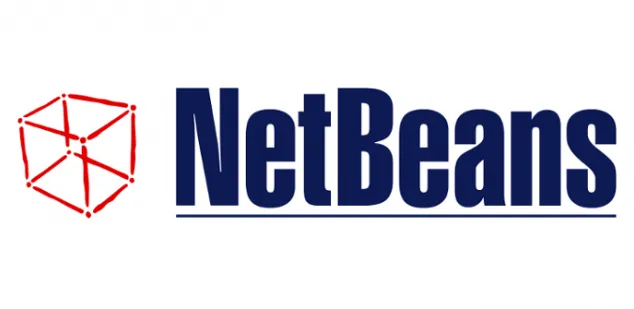
NetBeans is a free and open-source IDE. Ideal for editing existing projects or starting from scratch, NetBeans boasts a simple drag-and-drop interface that comes with a myriad of convenient project templates. It is primarily used to develop Java applications, but you can download bundles that support other languages.
Languages supported: C, C++, Fortran, HTML 5, Java, PHP, and more
Pros of NetBeans
- Best Support for Latest Java Technologies
- Fast & Smart Code Editing
- Rich Set of Community-Provided Plugins
- Cross Platform Support
- Easy & Efficient Project Management
- Automatic deployment of your application, and debugging
- Integration with app servers or web containers
- Integration with control version systems like GIT or SVN
Cons of NetBeans
- It’s very heavyweight, has a lot, A LOT of plugins, and some of them you never need them
- Plugins are not customizable
- The debugger is slow, compared with IntelliJ or Eclipse
4. IntelliJ IDEA

IntelliJ IDEA is an integrated development environment (IDE) written in Java for developing computer software. It is developed by JetBrains (formerly known as IntelliJ), and is available as an Apache 2 Licensed community edition, and in a proprietary commercial edition. Both can be used for commercial development.
Language supported: Java, Groovy, Kotlin, Scala, JavaScript, TypeScript, and SQL
Pros of IntelliJ IDEA
- Deep insight into your code
- Smart & Chain completion
- Data flow analysis
- Cross Platform Support
- Inspections and quick-fixes
- Built-in version control, build tools, and testing units
Cons of IntelliJ IDEA
- The IDE is very slow to start. It’s very heavy on system resources, unlike other IDEs
- Ultimate Edition is the full version and is quite costly
- It would be great if IntelliJ had a workspace concept
5. CODE::BLOCKS
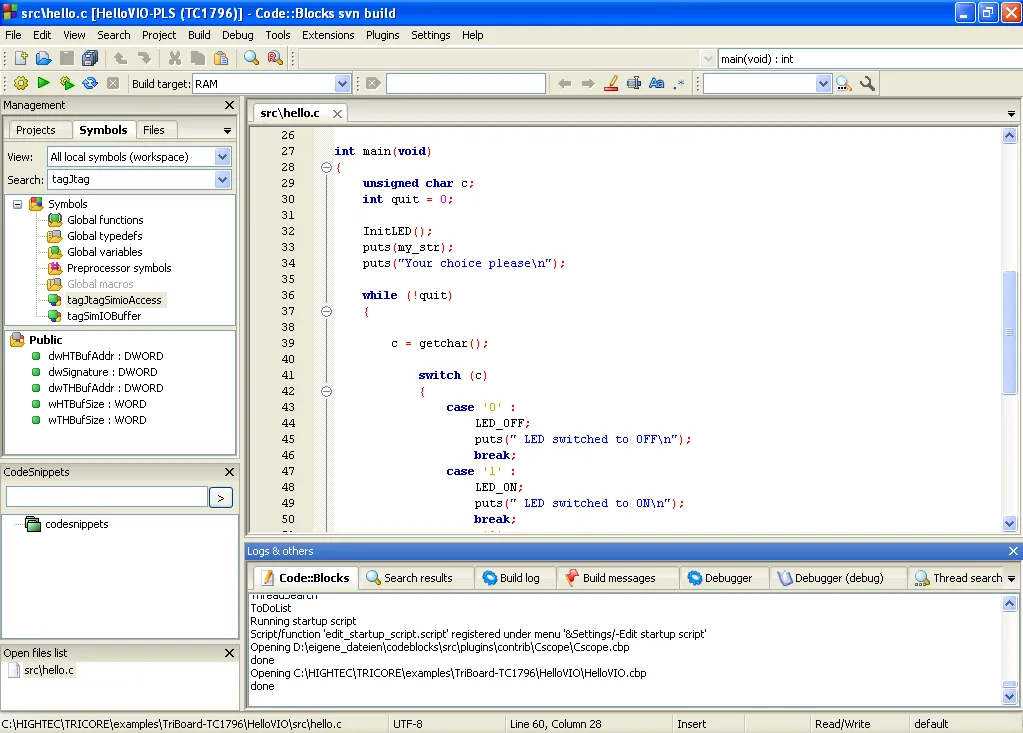
CODE:: BLOCKS is a free tool for programmers of C and C++. It can be configured according to your requirements and are highly flexible.
It allows you to program objects in a visual object-oriented approach and termed a class browser.
The main benefits of Code::Blocks are an open-source IDE environment, a free IDE solution, and a fully configurable and extensible IDE with functional tools for developers.
Languages supported: C, C++, Fortran
Pros of CODE::BLOCKS
- Good Debugger
- Inter-project dependencies generations
- Smart Indent and Code completion
- Multi-target project
- Full breakpoint support
Cons of CODE::BLOCKS
The code completion for Code::Blocks is rather poor compared to other IDEs and it supports fewer languages compared to others.
6. Xcode
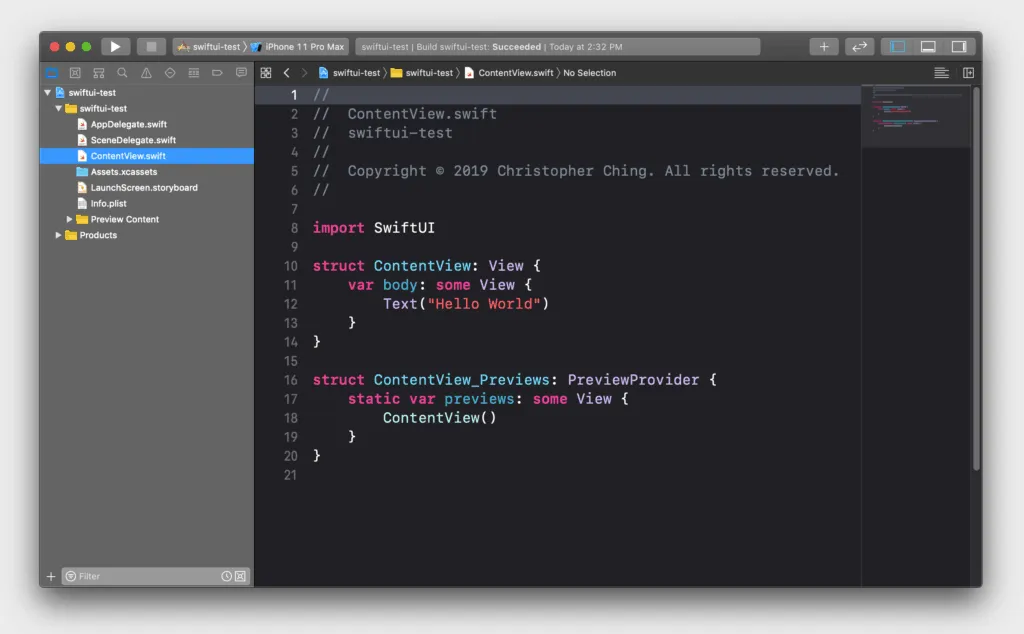
Xcode IDE is free, open source, and part of Xcode, which is a collection of tools for making apps for Apple devices such as the iPad, iPhone, and Mac. Integration with Cocoa Touch makes development in the Apple environment a breeze, and you can enable services such as Game Center or Passbook with a single mouse click. Built-in communication with the developer’s website helps users produce fully functioning apps on the fly.
Languages supported: C, C++, Objective-C, Objective-C++, Java, AppleScript, Python, Ruby, and Swift.
Pros of Xcode
- Equipped with a well-designed and easy-to-use UI creator
- Excellent code completion
- Xcode’s simulator lets you easily test your app while you build it in an environment that simulates your iPhone
- Coding assistant & Quick access
- User Interface Prototyping
- Source control and Version control
- Schemes Management
Cons of Xcode
Clunky and outdated Objective C makes it more frustrating if you are habituated to using a modern language and no support for tabbed work environments makes it difficult to work with multiple windows
7. Atom

Atom is a fantastic IDE for JavaScript programming. Because it’s created by GitHub, it means that there is a thriving community to turn to if you run into any issues. It works with Mac, Windows, and Linux and ships with a package manager for installing new packages. The app is highly customizable, but can also be used well without configuring or customizing anything.
Languages supported: C, C++, C#, COBOL, CSS, CoffeeScript, Go, HTML, Java, JavaScript, JSON, Perl, PHP, Ruby, Scala, SQL, and many others as well
Pros of Atom
- Lightweight & Integrated CLI
- Great UI which makes Atom very easy to use
- The large variety of extensions
- Coding assistant & Quick access
- User Interface Prototyping
- Source control and Version control
- Schemes Management
Cons of Atom
Sometimes Atom has plugin issues and the main setback is, that it doesn’t support version control and GIT.
8. Sublime Text 3
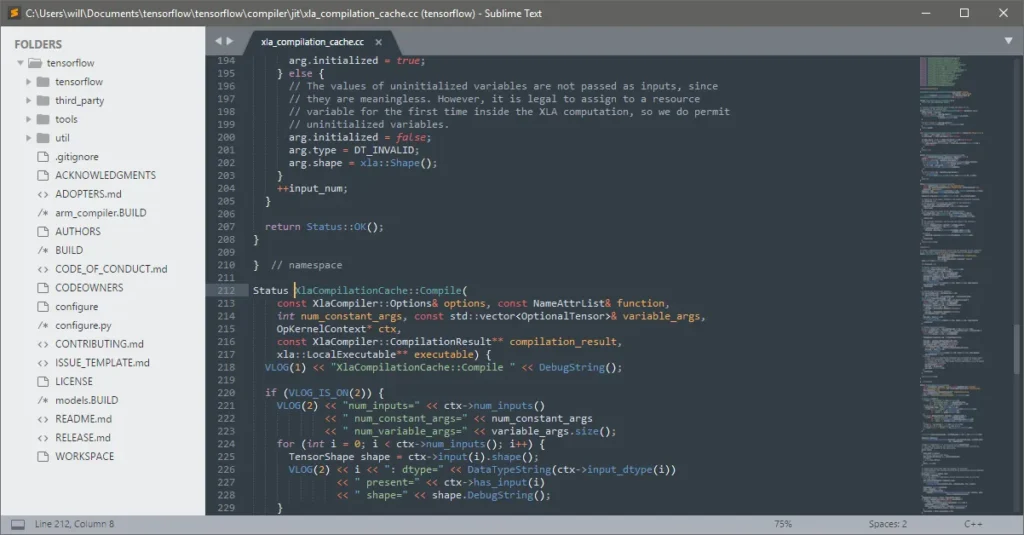
Sublime Text 3 (ST3) is a lightweight, cross-platform code editor known for its speed, ease of use, and strong community support. It’s an incredible editor right out of the box, but the real power comes from the ability to enhance its functionality using Package Control and creating custom settings.
Languages supported: C, C++, C#, COBOL, CSS, CoffeeScript, Go, HTML, Java, JavaScript, JSON, Perl, PHP, Ruby, Scala, SQL, and many others as well
Pros of Sublime Text 3
- Go to Anything, quick navigation to files, symbols, or lines
- Project-specific preferences
- The large variety of extensions
- Python-based plugin API
- Cross-platform (Windows, macOS, and Linux) and Supportive Plugins for cross-platform
Cons of Sublime Text 3
It has every functionality of IDE but it doesn’t have any in-built Compiling.
9. PHPStorm

PHPStorm is a great coding environment for those who work with PHP frameworks like WordPress, Drupal, Magento, and others. It has an interface that is both great to look at and easy to use. It’s compatible with Mac, Windows, and Linux and supports several different front-end programming languages like HTML5, CSS, JavaScript, and more. The IDE can be customized with themes and extensions to enhance your programming experience.
Languages supported: PHP and PHP frameworks
Pros of PHPStorm
- Visual debugger
- Automatic code completions and Error highlighting
- It also supports remote deployment
- Command-line tools
- REST Client, composer, and Docker
Cons of PHPStorm
Lacks support for some of the newer languages, such as PreCSS. A rigid project-based structure makes PhpStorm unsuitable for performing quick edits or taking throwaway notes. The cost, both financially and in system resources, may be prohibitive for some users.
10. AWS Cloud9
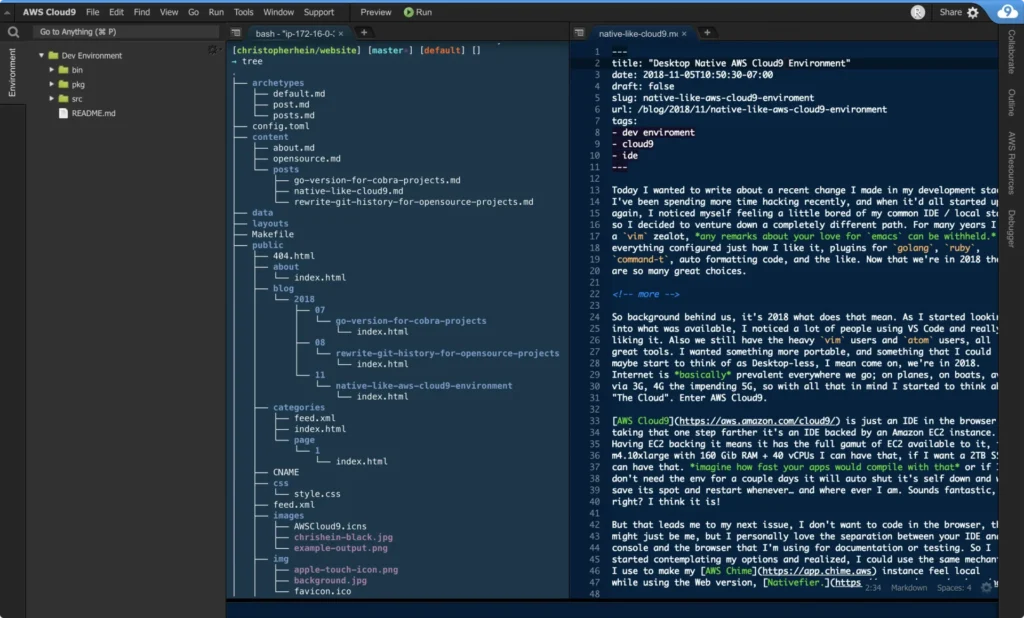
Amazon Web Services is a subsidiary of Amazon providing on-demand cloud computing platforms and APIs to individuals, companies, and governments, on a metered pay-as-you-go basis.
Languages supported: Java, Python, Ruby, PHP, Node.js, etc.
Pros of AWS Cloud9
- Build Serverless Applications with Ease
- Code with teammates in real-time
- Code with Just a Browser
- Loads New Projects Quickly
Cons of AWS Cloud9
You need to be experienced if you want to use AWS effectively and efficiently. Sometimes it’s really hard to choose the correct configuration that is suitable for your product as well as your pocket.

